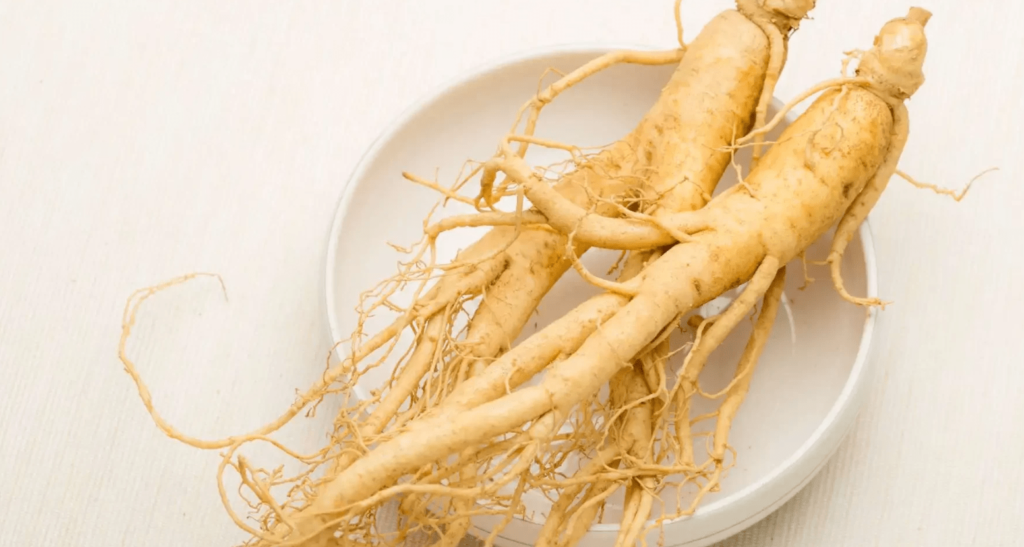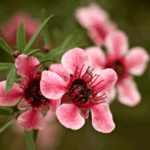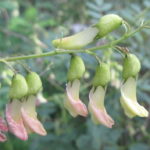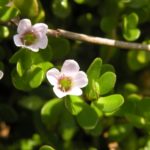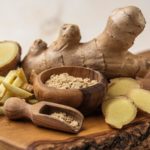
Marijana Jovanovic
(MEnvSci, BNatHerbMed, DipNut)
Ginseng plants are often used for their medicinal properties but vary significantly in their effects, active compounds, and traditional uses.
Korean ginseng extract has
- antitumor
- anti-fatigue
- antioxidant
- immune-boosting
- anti-inflammatory
- heart protective
- antimicrobial
- neuroprotective properties
Korean ginseng, widely used around the world and particularly in Korea and China, is renowned for its potent adaptogenic and cardio tonic properties, and will be the focus of this article.
Introduction
Ginseng plants belong to the Panax genus and consist of various species, where the three most well-known types are
- Asian/Korean ginseng (Panax ginseng)
- American ginseng (Panax quinquefolius)
- Siberian ginseng (Eleutherococcus senticosus)[1,2]
The name “ginseng” refers to Chinese words ”Gin” that translates to ”man” and ”seng” means ”essence,” highlighting its vital energy.
The term “Panax” is derived from Greek, where ”pan” means ”all” and ”akos” means ”cure,” indicating its traditional use as a universal remedy or cure-all diseases.[1,3,4,5]
Ginseng comes from the Araliaceae family.[1,3,4] While we will be focusing on Korean ginseng, it’s also important to mention other types of ginseng.
Commonly used in North America, American ginseng is valued for its calming and anti-stress effects.
Siberian ginseng, though also noted for its adaptogenic qualities and commonly used in Russia and parts of Asia, is less widely recognized and considered less potent compared to Korean and American ginseng.
Korean ginseng is a slow-growing perennial herb with a lifespan of approximately 4–6 years. It has thick, fleshy roots and has been used in herbal medicine for thousands of years, with detailed descriptions in Chinese texts dating back to AD 196.
In traditional Chinese medicine (TCM), ginseng is valued as the most potent Qi, or energy tonic.[1,3,4,6]
Other names
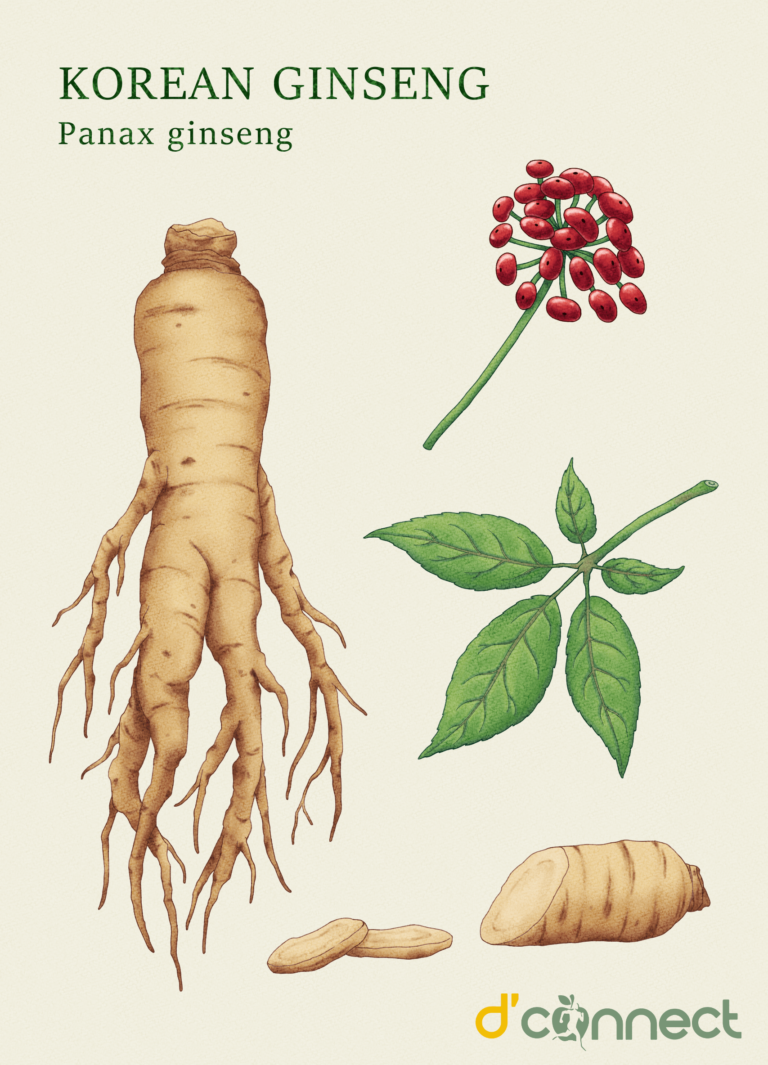
Botanical name: Panax ginseng.
Common names: Korean ginseng, Asian ginseng, Panax, red ginseng, white ginseng.
English: Man root.
French: Racine de ginseng.
German: Ginsengwurzel, Kraftwurzel.
Latin: Ginseng radix.
Mandarin: Ren shen.
Cantonese: Yan sam.
Korean: Insam.
Japanese: Ninjin.[1,3,4,7]
Characteristics
Korean ginseng is a perennial, self-pollinating herb native to the mountainous regions of China, Japan, Korea, and the former Soviet Union.
It is typically grown from seeds that take up to two years to sprout, with the seeds harvested from plants at least four years old.
The roots, which are white or pale yellow, grow upright with a primary root and several rootlets, whose size and shape vary based on water, soil, and weather.
Ginseng roots are considered most valuable between 4 and 6 years of age, as younger roots are considered immature and are not used for medicinal purposes.
The plant has a single stalk, compound leaves, and flowers in its third year, producing small yellow and pink blooms and red berries. The plant has an aromatic odour and a sweet taste.[1,3,8,9]
Ginseng contains a variety of bioactive compounds, such as phenolic compounds, polysaccharides, alkaloids, terpenoids, and flavonoids.[1,7,10,11,12]
Some of the main active constituents responsible for Korean Ginseng’s actions consist of:
- Polysaccharides including ginsenans PA and PB
- Salicylic and vanillic acids, diacetylenes, peptides, volatile alcohols, trilinolein and other lipids
- Triterpene saponins, a mixture of dammarane and oleanane saponins, commonly called ginsenosides (up to 3%)
- Volatile oil (0.05%) including:
- Sesquiterpenes
- Monoterpenes
- Polyacetylenes
- Seventeen amino acids (in particular glutamine and arginine)
RELATED — What are Amino Acids and what is their role in keeping us healthy?
Unique to Panax ginseng are triterpenoid saponins- ginsenosides, with over 150 types identified.[6,13]
Energetic qualities of Korean Ginseng are sweet, somewhat bitter, warm, dry, restoring, stimulating, nourishing, relaxing and rising.[7]
Use
Traditional Use
Korean ginseng has a long history of use among indigenous peoples in Russia, Korea, and northeast China.
Known as the “longevity herb”, its therapeutic properties are deeply embedded in their cultural myths and traditions. The root’s mysteries are intertwined with ancient spiritual practices rooted in Earth-based shamanism.
Its adaptogenic, restorative, and regulatory benefits have been recognized by northeast Asians since prehistoric times.[7]
Medicinal Use
Since the 1960s, extensive research has shown that Korean ginseng benefits the whole body rather than targeting specific organs.
It significantly impacts cellular metabolism, supporting its traditional use as a tonic that revitalizes the entire body — something not seen in conventional medicine.
Medicinal ginseng primarily includes the main and lateral roots, while smaller root hairs, more commonly used in the West, are considered lower quality.
The European pharmacopoeia specifies that the root should be cylindrical or fusiform, about 20 cm long and 2.5 cm in diameter, with a pale yellow to brownish-red surface. Most ginseng is cultivated, though wild ginseng is considered higher quality and more expensive.[5]
Wild ginseng is considered higher quality
There are two main types of Korean ginseng. Red ginseng, which is steamed before drying, and white ginseng, which is simply dried. Steaming red ginseng is believed to enhance its potency by changing the composition of its ginsenosides.[6,12]
Research shows that Korean ginseng and its active compounds, ginsenosides, help regulate the endocrine, nervous, immune, metabolic, and circulatory systems.
Korean ginseng extract is also linked to antitumor, anti-fatigue, antioxidant, immune-boosting, anti-inflammatory, heart protective, liver protectant and detoxicant, antimicrobial, and neuroprotective effects.[7,14,15]
Nutritional facts
Korean Ginseng contains
- Vitamin B1 (Thiamine)
- Vitamin B2 (Riboflavin)
- Vitamin B3 (Niacin)
- Vitamin B5 (Pantothenic acid)
- Vitamin B7 (Pantothenic acid)
- Vitamin B12 (Cobalamin)
and 20 trace minerals including
- Germanium
- Zinc (for immunity, skin health and libido)
- Copper: Heart, Hair and Skin Health
- Iron (for immunity support and energy production)
- Sodium (for nerve health, and fluid and minerals equilibrium)
- Potassium (for blood pressure, heart rhythm and pH balance)
- Calcium (for healthy bones, teeth and heart)
- Magnesium (for a great night of sleep)
- Cobalt
- Manganese
- Vanadium[5]
- Vanadium[5]
Health benefits
Research demonstrated that orally ingested ginsenoside becomes active after being processed by intestinal bacteria and then combined with fatty acids.
It passes through the stomach and small intestine without being broken down by stomach acid or liver enzymes. It becomes active once it reaches the large intestine, where colonic bacteria break it down into smaller metabolites. These metabolites are then combined with fatty acids, which allow them to stay active in the body for a longer time.
This process means that ginsenoside acts as a prodrug, only becoming active after being modified by intestinal bacteria and fatty acids.[16]
Korean Ginseng as adaptogen
In traditional Chinese medicine, plant-based adaptogens are believed to work by balancing the body’s yin and yang, which represents achieving harmony and vitality within the body.
Adaptogens boost energy flow, reduce stress, enhance mental performance, and improve sleep by regulating the HPA axis, which controls the body’s stress response.[17,18]
While the anti-stress effects of Panax ginseng aren’t fully understood, studies show that it affects both the adrenal glands and the hypothalamic-pituitary-adrenal (HPA) axis in various ways.[19,20,21]
Unfortunately, although there are plenty of animal studies on Panax ginseng and stress, research involving humans is rare.
Both the German Commission E and the World Health Organisation (WHO) approve Korean ginseng for use during recovery periods and for boosting energy and concentration when fatigued or experiencing reduced work capacity.[7,11]
Two studies examined the stress-reducing effects of ashwagandha and ginseng. The first study used the Perceived Stress Scale (PSS) to assess stress levels in participants, while the second study measured stress with the Hamilton Anxiety Rating Scale (HAM-A) and the Depression, Anxiety, Stress Scale-21 (DASS-21).[18,22]
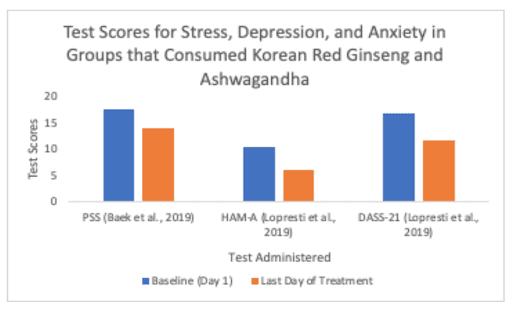
Studies concluded that both adaptogens lowered stress levels similarly, though ashwagandha had a slightly stronger effect.
Ginseng was associated with a 27% reduction in stress, while ashwagandha showed reductions of 41% and 30% in different measures. The study highlights the potential of these adaptogens as natural stress relievers, though more research is needed, particularly on long-term effects and comparisons between different adaptogens.[23]
Korean ginseng can lower stress and boost energy levels
A double-blind, balanced crossover design, placebo-controlled study that investigated the effects of a single dose of Korean ginseng on cognitive performance and mental fatigue, focused on 30 healthy volunteers.
The study aimed to evaluate the effects of Panax ginseng on
- mental performance
- fatigue
- well-being
Participants were randomly assigned to receive either 200 mg of Panax ginseng, 400 mg of Panax ginseng, or a placebo daily. The results indicated significant improvements in mental performance and mental fatigue during continuous mental activity in the Panax ginseng groups compared to the placebo group, suggesting its potential adaptogenic.[24]
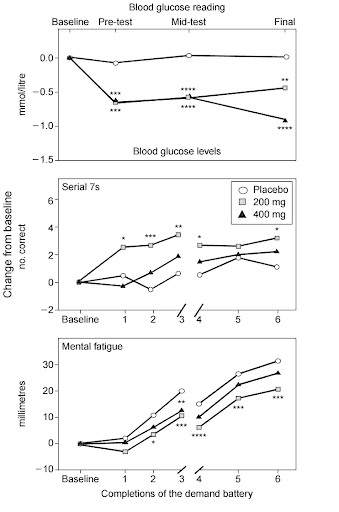
Korean Ginseng as cardiovascular support
Ginseng has been shown to support heart health by improving
- blood glucose control
- lowering blood pressure
- reducing oxidative stress
- preventing platelet clumping
- correcting lipid imbalances
in animal studies.
Ginseng is known for its heart-protective effects, including reducing oxidative stress, inflammation, and blood clotting, making it a potential treatment for cardiovascular diseases.
Ginseng has shown a range of heart-protective effects that may benefit those with heart failure. It helps shield heart tissues from stress-related damage without significant side effects.
In one study rats were treated with ginseng (400 mg/kg). Peroxisome proliferator-activated receptors (PPARδ) expression and TnI phosphorylation levels significantly increased, boosting heart contractility without affecting heart rate. When PPARδ was blocked with ginseng (GSK0660), this effect on contractility diminished.
It was concluded that ginseng can improve heart muscle contraction by increasing Peroxisome proliferator-activated receptors (PPARs) expression, a key factor in heart function.[25]
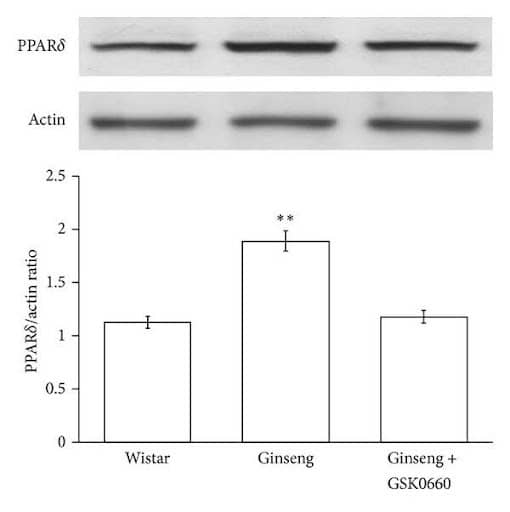
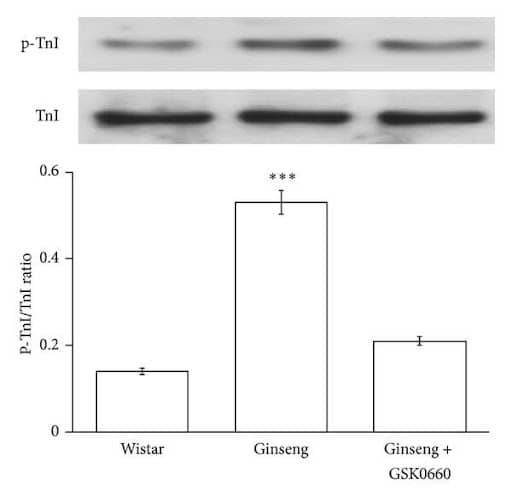
These studies collectively support ginseng’s potential role in limiting heart muscle damage, reducing heart failure symptoms, and protecting against cardiac injury.[26]
Early research in China found that red ginseng combined with digoxin may improve severe heart failure outcomes more effectively than either treatment alone, suggesting ginseng’s potential as an additional therapy.
Another ginseng extract, Shenfu, has also shown benefits for heart failure patients, including enhanced quality of life and reduced inflammation.[27]
Korean red ginseng (KRG) might help reduce arterial stiffness and blood pressure in people with coronary artery disease (CAD), though its effects on cholesterol and other blood lipids are unclear.
In a study, 20 patients with stable angina took KRG (2.7 g/day) or a placebo for 10 weeks, alternating between them. Results showed that KRG significantly lowered systolic blood pressure and measures of arterial stiffness, like brachial-ankle and heart-femoral pulse wave velocity.
Korean ginseng might assist with high blood pressure
The placebo had no significant effect. Overall, KRG may be beneficial for CAD by improving blood pressure and reducing arterial stiffness.[28]

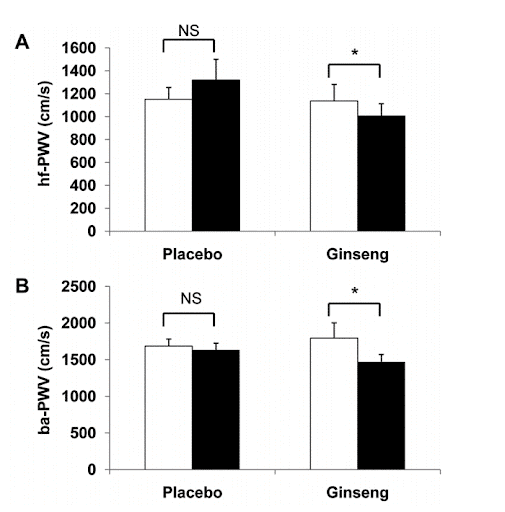
Korean Ginseng for brain health
Korean ginseng has been found to improve
- cognitive function
- reduce fatigue
- enhance overall well-being
Ginsenosides have neuroprotective effects on both peripheral and central nervous systems. Traditionally, Korean Ginseng has been used in TCM for dementia and to promote concentration and memory.[11]
Researchers have examined how ginsenoside Rg1 from ginseng affects memory impairment. Rg1 has been shown to enhance memory acquisition, consolidation, and retrieval, improving performance in tasks like the Morris water maze and passive avoidance tests.[29]
A study using rats concluded that ginsenosides Rg1 and Rb1 improve memory and learning.[30]
Apoptosis is a controlled cell death process essential for development and disease prevention. When it malfunctions, it can lead to cancer or neurodegenerative diseases.
Ginsenoside Rg1 has been found to prevent neuron cell death by
- lowering nitric oxide (NO) levels
- reducing calcium inside cells
- boosting antioxidant activity
It also increases protective proteins (Bcl-2) and inhibits harmful ones while blocking the cell-death enzyme caspase-3, which may explain its anti-aging and neuroprotective effects.[31]
Alzheimer’s disease, a common neurodegenerative disorder, is marked by memory loss and dementia in older adults due to amyloid plaque buildup and neurofibrillary tangles in the brain.
Studies show that ginsenoside Rg3 can reduce inflammation by lowering cytokine levels and inhibiting NF-κB activity in microglial cells, suggesting it may help treat chronic neurodegenerative diseases like Alzheimer’s.[32]
A study on mice, focusing on Rg3 and its role in immune response modulation, showed that Rg3 decreased immune cell accumulation caused by zymosan injection by 60% at a low dose and 93% at a high dose.[33]
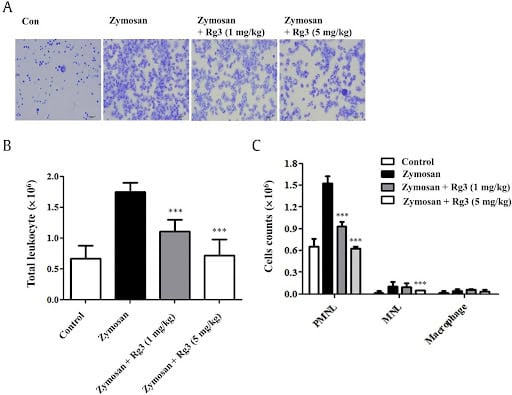
Various human studies have combined Ginkgo and Korean ginseng to evaluate their effects on mental function. The findings showed:
- Improved performance in memory tests, both for working memory and long-term memory
- Reduced fatigue and better sleep quality
- Positive effects on brain activity in young participants after just one dose
- Enhanced response speed, accuracy, and frequency in repetitive and memory tasks for healthy adults
- Better cognitive performance, as seen in EEG results, with Korean ginseng performing better than Ginkgo.[34,35,36]
Korean Ginseng for immunity
The immune system is crucial for protecting the body, responding to threats by either stimulating or suppressing itself. Ginsenosides can both boost and regulate the immune system, depending on the situation.[37]
Ginseng has been shown to influence the immune system in many ways, such as
- helping immune cells grow
- boosting their ability to fight off threats
- increasing the production of antibodies and cytokines
Animal studies have demonstrated that ginseng triggers a strong immune response, offering protection against viral and bacterial infections and even enhancing the effectiveness of vaccines.[38]
The effects of Panax ginseng extract on the immune response to a flu vaccine was studied in a 12-week, double-blind trial with 227 participants.
The group taking 100 mg of ginseng twice daily showed double the natural killer (NK) cell activity compared to the placebo group.
They also had higher antibody levels and fewer upper respiratory infections (15 cases in the ginseng group versus 42 in the placebo group), which supports ginseng’s role in boosting the immune system.[39]
In another research paper, which was an eight-week double-blind, placebo-controlled study, 60 healthy volunteers took either 100 mg of Ginsana (G115), 100 mg of liquid ginseng extract, or a placebo twice daily.
The ginseng groups showed consistent improvement in immune activity by week four and significant differences by week eight, including
- better Polymorphonuclear leukocytes (PMN) cell movement
- better phagocytosis
- increase in T-helper cells (immune cells that detect infections and activate other cells to fight them)
- increase in T-suppressor cells ( also known as Regulatory T cells (Tregs) – essential for maintaining immune tolerance and preventing autoimmune diseases).
The study concluded that ginseng extract boosts the immune system, with the standardized extract being more effective than the liquid form.[40]
Korean Ginseng as a cancer preventative
Many in vitro and animal studies have explored how Panax ginseng affects cancer growth, cell death, blood vessel formation, and cancer spread.
Korean ginseng might slow cancer progression through its anti-inflammatory effects, targeting important proteins like COX-2, iNOS, and NF-κB. and can protect against radiation damage due to its antioxidant and immune-strengthening properties.[41,42]
A study from the Korea Cancer Centre Hospital found that ginseng consumers had about half the risk of developing cancer compared to non-consumers (odds ratio = 0.50).
Various forms of ginseng, including fresh ginseng extract, white ginseng extract, white ginseng powder and red ginseng, were associated with lower cancer risks, while ginseng fresh slices, juice, and tea showed no benefits.
Increased ginseng intake correlated with reduced risks for several cancers, particularly in smokers. Overall, ginseng consumption appears linked to a lower risk of most cancers, highlighting its potential protective effects.[43]
Another study, focused on individuals over 40, found that Korean ginseng users had a notably lower risk of stomach and lung cancers.
Consumption of ginseng is linked to lower cancer risk
The study also showed a dose-response relationship, where more frequent Korean ginseng consumption led to a lower cancer risk.
Ginseng users showed a lower risk of cancer compared to non-users. Also, no cancer deaths were recorded among 24 red ginseng users.
Korean Ginseng as anti-inflammatory and for wound healing
Korean ginseng has several beneficial effects on different skin cell types like keratinocytes, melanocytes, fibroblasts, and skin stem cells.
In keratinocytes, it helps protect against UV damage, reduces inflammation, and acts as an antioxidant by repairing DNA damage and improving cell survival. It also decreases inflammatory molecules, making it useful in treating conditions like atopic dermatitis.
Korean ginseng aids in wound healing by promoting the growth of skin cells and boosting factors related to tissue repair.
This includes collagen production, reduction in oxidative stress, and diminishing signs of aging in fibroblasts.
Therapeutic dosage
The safe dosages include:
- Decoction of dried root: 0.5-3g, three times a day
- Fluid extract (1:2) (30%) 1-6 ml, three times a day[1,3,7,8]
Many clinical trials have used a daily dose of 200 mg of a 5:1 standardized extract, typically in tablet or capsule form.
It is suggested to start with a lower dose and increase it gradually, as everyone is unique and responds differently. It is generally recommended to be taken up to three months.
For long term use a cyclic approach is recommended and low doses that are periodically interrupted due to cumulatively stimulant quality of Korean ginseng, (e.g. 15-20 days on Korean Ginseng followed with 2 weeks without).
Safety concerns
Korean ginseng is a popular herb, but because of its high demand, it’s often adulterated or mislabelled. To ensure sufficient ginsenoside content, consistent effects, and lowering the risk of side effects or toxicity, it’s best to use only standardized ginseng products.
The intake of a standardised extract is considered to be safe and there are very few reports associated with side effects.[1,5,8]
However, due to quality control and adulteration of the herbal preparation many commercial preparations of Korean ginseng demonstrated side effects due to the quality of Korean ginseng used, use of nonofficial parts of the Korean ginseng plant, and lack of quality control.
Symptoms of overuse or excessive dosage include
- irritability
- sleep loss
- skin rashes
- high blood pressure
- morning diarrhoea
Korean ginseng is traditionally not recommended for people with
- acute asthma
- heavy periods
- frequent nosebleeds
It should be used with caution in people with known risk factors for hypertension and pituitary, thyroid and adrenomedullary hyperfunction.
Possible interactions with medications
Reports of interactions exist for the following pharmaceutical medications:
- Albendazole
- Hypoglycaemic drugs (Diabete, Micronase, Nardil)
- Insulin
- Digoxin
- Warfarin
- MAOI antidepressants (phenelzine, isocarboxazid, phenelzine, selegiline, and tranylcypromine)
- Clomipramine
- Haloperidol.[1,3,4,8]
Possible interactions with herbs and supplements
No interactions with herbs and nutritional supplements were identified.
It is advised to avoid using Korean ginseng alongside caffeine or amphetamines, as it may amplify stimulant effects.[1,3,4,8]
Summary
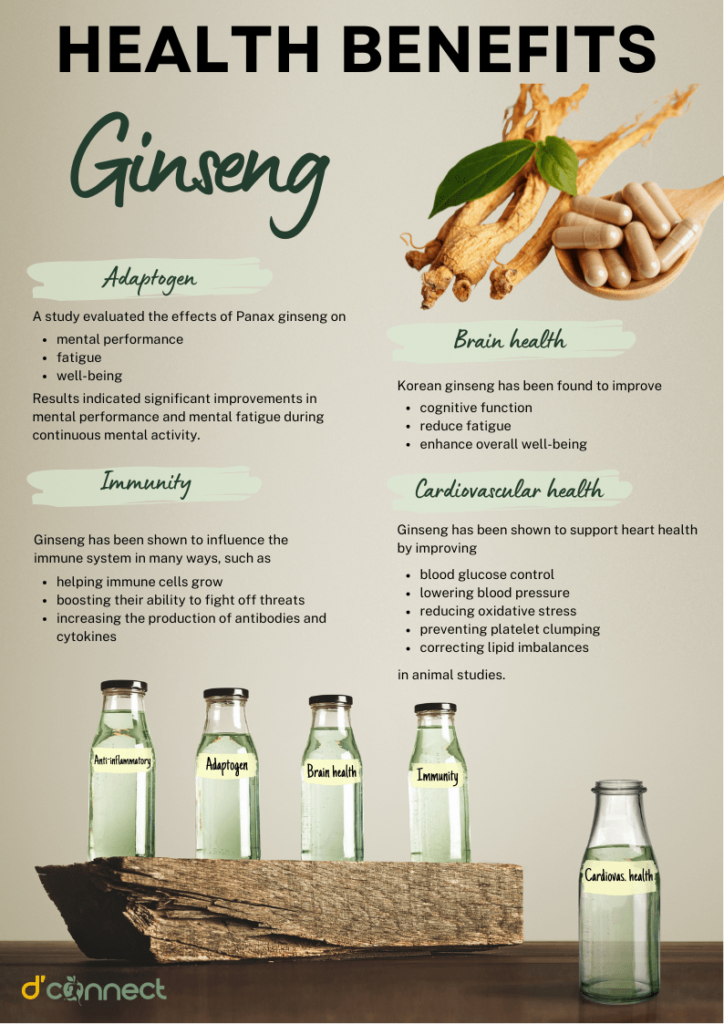
Note — feel free to share or download this illustration.
Related Questions
1. Can ginseng assist with sexual dysfunction in men?
Ginseng, particularly Korean red ginseng, may help treat male sexual dysfunction by improving blood flow, boosting nitric oxide production, and enhancing libido.
Its stress-relieving properties can also support sexual performance.
2. Can ginseng increase testosterone levels?
At the moment, current research does not conclusively show a direct significant increase in testosterone levels from ginseng alone.
3. Can ginseng assist seniors when exercising to increase muscle mass and reduce sarcopenia?
Ginseng may help seniors increase muscle mass and combat sarcopenia by
- enhancing exercise performance
- boosting energy
- improving recovery
This is supported by studies that show Ginseng’s positive effects on muscle growth and strength.
Marijana is a qualified Naturopath, Medical Herbalist, Nutritionist and Neo-Shamanic Energy Healer based in Auckland. Marijana’s life path took her from a career in industrial chemistry and environmental science to natural medicine and energy healing….
If you would like to learn more about Marijana, see Expert: Marijana Jovanovic.
References
(1) Fisher, C. (2009). Materia medica of western herbs. Vitex Medica.
(2) Li, Z., Wang, Y., Xu, Q., Ma, J., Li, X., Tian, Y., Wen, Y., & Chen, T. (2023). Ginseng and health outcomes: an umbrella review. Frontiers in Pharmacology, 14,1-13, https://doi.org/10.3389/fphar.2023.1069268
(3) Braun, L., & Cohen, M. (2015). Herbs and natural supplements: An evidence-based guide. (4th ed). Elsevier Health Sciences.
(4) Bone, K., & Mills, S. (2013). Principles and practice of phytotherapy (2nd ed.). Edinburgh, Scotland: Churchill Livingstone Elsevier.
(5) Todorova, V., Ivanov, K., & Ivanova, S. (2022). Comparison between the biological active compounds in plants with adaptogenic properties (Rhaponticum carthamoides, Lepidium meyenii, Eleutherococcus senticosus, and Panax ginseng). Plants, 11(1), 64. https://doi.org/10.3390/plants11010064
(6) Park, C.W., Kim, YH., Kim, YJ. (2024). Bioactive Compounds and Biological Activities of Korean Ginseng (Panax ginseng Meyer). In: Murthy, H.N., Paek, K.Y., Park, SY. (eds) Bioactive Compounds in the Storage Organs of Plants. Reference Series in Phytochemistry. Springer, Cham.
(7) Holmes, P. (2007). The energetics of western herbs: A materia medica integrating western & Chinese herbal therapeutics: Vol.1 (Rev. ed.) (4th ed.). Boulder, CO: Snow Lotus Press.
(8) Murray, M.T. (2013). Panax ginseng (Korean Ginseng). In J. E. Pizzorno & M. T. Murray, Textbook of natural medicine (4th ed., pp. 919-929). St Louis, MO: Elsevier.
(9) Choi, K. (2008). Botanical characteristics, pharmacological effects, and medicinal components of Korean Panax ginseng C. A. Meyer. Acta Pharmacologica Sinica, 29(9), 1109–1118. https://doi.org/10.1111/j.1745-7254.2008.00869.x
(10) Patel, S., & Rauf, A. (2017). Adaptogenic herb ginseng (Panax) as medical food: Status quo and future prospects. Biomedicine & pharmacotherapy = Biomedecine & pharmacotherapie, 85, 120–127.
(11) Ganora, L. (2009). Herbal constituents. Foundation of phytochemistry. Louisville, CO: Herbalchem Press.
(12) Lee, S. M., Bae, B. S., Park, H. W., Ahn, N. G., Cho, B. G., Cho, Y. L., & Kwak, Y. S. (2015). Characterization of Korean red ginseng (Panax ginseng Meyer): History, preparation method, and chemical composition. Journal of Ginseng Research, 39(4), 384–391. https://doi.org/10.1016/j.jgr.2015.04.009
(13) Park, J. D., Rhee, D. K., & Lee, Y. H. (2005). Biological activities and chemistry of saponins from Panax ginseng C. A. Meyer. Phytochemical Reviews, 4(2-3), 159–175. https://doi.org/10.1007/s11101-005-2835-8
(14) Hechtman, L. (2012). Clinical naturopathic medicine (1st ed.). Chatswood, N.S.W: Elsevier Australia.
(15) Mancuso, C., & Santangelo, R. (2017). Panax ginseng and Panax quinquefolius: From pharmacology to toxicology. Food and chemical toxicology : an international journal published for the British Industrial Biological Research Association, 107(Pt A), 362–372. https://doi.org/10.1016/j.fct.2017.07.019
(16) Hasegawa, H. (2004). Proof of the mysterious efficacy of ginseng: Basic and clinical trials: Metabolic activation of ginsenoside: Deglycosylation by intestinal bacteria and esterification with fatty acid. Journal of Pharmacological Sciences, 95(2), 153-157.
(17) Liao, L., He, Y. F., Li, L., & et al. (2018). A preliminary review of studies on adaptogens: Comparison of their bioactivity in TCM with that of ginseng-like herbs used worldwide. Chinese Medicine, 13, 57. https://doi.org/10.1186/s13020-018-0214-9
(18) Baek, J. H., Heo, J.-Y., Fava, M., Mischoulon, D., Choi, K. W., Na, E. J., Cho, H., & Jeon, H. J. (2019). Effect of Korean Red Ginseng in individuals exposed to high stress levels: A 6-week, double-blind, randomized, placebo-controlled trial. Journal of Ginseng Research, 43(3), 402–407. https://doi.org/10.1016/j.jgr.2018.03.001
(19) Fulder, S. J. (1981). Ginseng and the hypothalamic-pituitary control of stress. American Journal of Chinese Medicine, 9(2), 112–118.
(20) Hiai, S., Yokoyama, H., Oura, H., & Yano, S. (1979). Stimulation of pituitary-adrenocortical system by ginseng saponin. Endocrinologia japonica, 26(6), 661–665.
(21) Ratan, Z. A., Youn, S. H., Kwak, Y. S., Han, C. K., Haidere, M. F., Kim, J. K., Min, H., Jung, Y. J., Hosseinzadeh, H., Hyun, S. H., & Cho, J. Y. (2021). Adaptogenic effects of Panax ginseng on modulation of immune functions. Journal of Ginseng Research, 45(1), 32-40. https://doi.org/10.1016/j.jgr.2020.09.004
(22) Lopresti, A. L., Smith, S. J., Malvi, H., & Kodgule, R. (2019). An investigation into the stress-relieving and pharmacological actions of an ashwagandha (Withania somnifera) extract. Medicine, 98(37). https://doi.org/10.1097/md.0000000000017186
(23) Serai, M. (2021). Biologically active compounds like ashwagandha and ginseng work as stress relievers and alternatives to antidepressants. University of Washington Bothell, Campus Research and Observational Writings, 6.
(24) Reay, J. L., Kennedy, D. O., & Scholey, A. B. (2005). Single doses of Panax ginseng (G115) reduce blood glucose levels and improve cognitive performance during sustained mental activity. Journal of psychopharmacology (Oxford, England), 19(4), 357–365. https://doi.org/10.1177/0269881105053286
(25) Tang, M.-M., Zhao, S.-T., Li, R.-Q., & Hou, W. (2023). Therapeutic mechanisms of ginseng in coronary heart disease. Frontiers in Pharmacology, 14. https://doi.org/10.3389/fphar.2023.1271029
(26) Kim J. H. (2012). Cardiovascular Diseases and Panax ginseng: A Review on Molecular Mechanisms and Medical Applications. Journal of ginseng research, 36(1), 16–26.
(27) Karmazyn, M., & Gan, X. T. (2017). Treatment of the cardiac hypertrophic response and heart failure with ginseng, ginsenosides, and ginseng-related products. Canadian Journal of Physiology and Pharmacology.
(28) Chung, I.-M., Lim, J.-W., Pyun, W.-B., & Kim, H.-Y. (2010). Korean Red Ginseng Improves Vascular Stiffness in Patients with Coronary Artery Disease. Journal of Ginseng Research. Elsevier BV. https://doi.org/10.5142/jgr.2010.34.3.212
(29) Wang, X. Y., & Zhang, J. T. (2001). Effects of ginsenoside Rg1 on learning and memory impairment induced by β-amyloid peptide (25-35) and its mechanism of action. Acta Pharmacologica Sinica, 36, 1–4.
(30) Chang, Y., Huang, W. J., Tien, L. T., & Wang, S. J. (2008). Ginsenosides Rg1 and Rb1 enhance glutamate release through activation of protein kinase A in rat cerebrocortical nerve terminals (synaptosomes). European Journal of Pharmacology, 578(1), 28–36.
(31) Chen, X. C., Chen, Y., Zhu, Y. G., Fang, F., & Chen, L. M. (2002). Protective effect of ginsenoside Rg1 against MPTP-induced apoptosis in mouse substantia nigra neurons. Acta Pharmacologica Sinica, 23(8), 829–834.
(32) Joo, S. S., Yoo, Y. M., & Ahn, B. W. (Eds.). (2008). Prevention of inflammation-mediated neurotoxicity by Rg3 and its role in microglial activation. Biological & Pharmaceutical Bulletin, 31(8), 1392–1396.
(33) Kang, S., Park, S. J., Lee, A. Y., Huang, J., Chung, H. Y., & Im, D. S. (2018). Ginsenoside Rg3 promotes inflammation resolution through M2 macrophage polarization. Journal of Ginseng Research, 42(1), 68-74. https://doi.org/10.1016/j.jgr.2016.12.012
(34) Coleman, C.I., Hebert, J.H. and Reddy, P. (2003). The effects of Panax ginseng on quality of life. Journal of Clinical Pharmacy and Therapeutics, 28, 5-15. https://doi.org/10.1046/j.1365-2710.2003.00467.x
(35) Wesnes, K. A., Ward, T., McGinty, A., & Petrini, O. (2000). The memory enhancing effects of a Ginkgo biloba/Panax ginseng combination in healthy middle-aged volunteers. Psychopharmacology, 152(4), 353–361.
(36) Kennedy, D. O., & Scholey, A. B. (2003). Ginseng: potential for the enhancement of cognitive performance and mood. Pharmacology, biochemistry, and behavior, 75(3), 687–700.
(37) You, Y., Cha, S., Jae, M.Y., & Cho, Y. (2022). Ginsenosides are active ingredients in Panax ginseng with immunomodulatory properties from cellular to organismal levels, Journal of Ginseng Research,46(6), 711-721. https://doi.org/10.1016/j.jgr.2021.12.007
(38) Bilia, A.R., & Bergonzi, M. C. (2020). The G115 standardized ginseng extract: an example for safety, efficacy, and quality of an herbal medicine, Journal of Ginseng Research, 44(2),179-193. https://doi.org/10.1016/j.jgr.2019.06.003
(39) Scaglione, F., Cattaneo, G., Alessandria, M., & Cogo, R. (1996). Efficacy and safety of the standardised Ginseng extract G115 for potentiating vaccination against the influenza syndrome and protection against the common cold [corrected]. Drugs under experimental and clinical research, 22(2), 65–72.
(40) Scaglione F, Ferrara F, Dugnani S, et al. (1990). Immunomodulatory effects of two extracts of Panax ginseng C.A. Meyer. Drugs Under Experimental and Clinical Research,16(10), 537-542. PMID: 2100737.
(41) Kim, S., Kim, N., Jeong, J., Lee, S., Kim, W., Ko, S.-G., & Kim, B. (2021). Anti-cancer effect of Panax ginseng and its metabolites: From traditional medicine to modern drug discovery. Processes, 9(8), 1344. https://doi.org/10.3390/pr9081344
(42) Lee, T.K., Johnke, R.M., Allison, R.R., O’Brien, K.F., & Dobbs, L.J. (2005). Radioprotective potential of ginseng, Mutagenesis, 20(4), 237–243.
(43) Yun, T. K., & Choi, S. Y. (1995). Preventive effect of ginseng intake against various human cancers: a case-control study on 1987 pairs. Cancer epidemiology, biomarkers & prevention : a publication of the American Association for Cancer Research, cosponsored by the American Society of Preventive Oncology, 4(4), 401–408.

